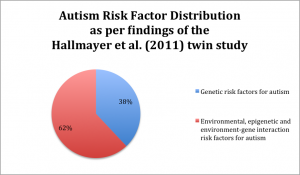NEW FINDING: OLDER DADS HAVE MORE GENETIC MUTATIONS THAN OLDER MOMS
As reported by Carey in the New York Times, researchers Kong et al. (2012) examined the genomes of 219 individuals in 78 family groups, including children, parents, and, in some cases siblings and grandparents. 44 individuals were diagnosed with autism spectrum disorder, and 21 were diagnosed with schizophrenia.
Although Kong et al. (2012) found an increase in “de novo” (new) genetic mutations with increased age of the mother and father, they indicated increased mutations were “mostly, maybe entirely, on the paternally inherited chromosome” (p. 472).
Kong et al. (2012) suggested increased father’s age could be contributing to the increase in autism prevalence.
RELATED FINDINGS: OLDER DADS AND MOMS ARE LINKED TO GREATER AUTISM RISK
Hultman et al. (2011) reported that fathers over 55 years old had a 4.4 times increased risk of having a child with autism.
Reichenberg et al. (2006) reviewed Israeli records for 318,506 17-year-olds: they found no link between age of mothers and autism risk, but found fathers over 40 were 5.75 times more likely to have children with autism than fathers who were 30 or younger.
Lauritsen, Pedersen, and Mortensen (2005) reviewed records for 818 Danish children with autism and found no effect of mothers’ age, but found fathers 35 years or older had 1.4 times the risk of having children with autism than 25-29 year old fathers.
Many researchers have reported that both increased age of the mother and increased age of the father carried increased risk for autism (Ben Itzchak et al., 2011; Croen et al., 2007; Durkin et al., 2008; King et al., 2009; Larsson et al., 2005; Parner et al., 2012; Shelton, Tancredi, & Hertz-Picciotto, 2010).
QUESTION 1: WHAT IS A DE NOVO MUTATION? A “de novo” mutation is new in an individual.
For most genes, we carry two versions or alleles, one from our mother, one from our father.
A mutation is a change in genetic sequence. Mutations can occur in an allele of any gene.
Mutations are caused primarily by one of four things:
mistakes in DNA replication—these increase as we age;
ionizing radiation penetrating earth’s atmosphere and passing through our bodies—these effects accumulate as we age;
chemical exposure—effects may accumulate as we age; and,
viruses.
QUESTION 2: IS IT LIKELY THAT DENOVO GENE MUTATIONS OF OLDER FATHERS ARE A FACTOR IN THE INCREASED PREVALENCE OF AUTISM?
NOT LIKELY.
First, the two major types of genetic causes of autism diagnoses are not de novo gene mutations, but are:
(a) single gene mutation disorders such as Rett syndrome, Fragile X syndrome, and tuberous sclerosis; and,
(b) multiple gene variants of many different types occurring together in one individual—this is called polygenic inheritance. At this time, between 400 and 1,000 existing—not de novo—gene variants have been linked to autism diagnoses.
Second, the genetic research findings of Neal et al. (2012), O’Roak et al. (2012) and Sanders et al. (2012) together with those of Kong et al. (2012) have found only 70 genes with a de novo genetic variant. (Kong et al. (2012) added evidence for mutations in two additional genes, CUL3 and EPHB2, linked to autism.)
Therefore, given the evidence that multiple gene variants of different types occurring together are one cause for autism diagnoses, there are likely to be only a handful of de novo mutations in older fathers that contribute to autism diagnoses.
THE KONG et al. (2012) FINDINGS ILLUSTRATE VARIATION AND COMPLEXITY IN AUTISM
The largest twin study of autism conducted to date (Hallmayer et al., 2011) found that, unlike earlier autism heritability studies, less than 40% of the variation between twins was attributable to genetic risk factors. If future twin studies support these findings then it will be established that more autism variance is explained by environmental risk factors than genetic risk factors.
The de novo genetic mutations older fathers may pass on to their children are definable as environmental risk factors and as genetic risk factors. Because the de novo mutation alters a gene sequence, the mutation’s effects are genetic effects. However, the environment caused the de novo mutation in the father.

